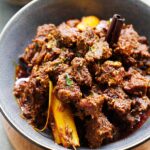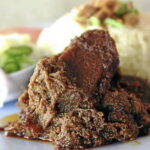Rendang: A Delicious Dish that Caused Tension between Malaysia and Indonesia
Rendang, the spicy braised meat dish, has become synonymous with the cultural traditions of both Malay and Minangkabau communities. As the Minangkabau people migrated from West Sumatra, Indonesia, to Negeri Sembilan, Malaysia, they brought along their culinary expertise, including the art of preparing rendang. This delectable dish has sparked debates and friendly disputes between Malaysia and Indonesia, with both countries claiming it as their own. Let’s delve into the rich history and unique flavours of rendang, celebrating its status as a shared culinary heritage between these neighbouring nations.
The roots of rendang can be traced back to a Malay manuscript from the early 16th century, where it referred to the slow cooking or roasting of goat meat. However, the dish gained prominence during the Portuguese occupation of Melaka (Malacca), which brought Portuguese culinary influences to the region. As both Malaysia and Indonesia embraced various foreign culinary influences, rendang evolved into a popular dish that incorporated Indian spices and cooking techniques. This fusion of flavours and cooking styles contributed to the unique character of rendang we know today.
The Minangkabau people, known for their wandering culture, adopted rendang as a means of preserving food during their travels. The dish combines readily available ingredients such as coconut milk, hot chillies, and a medley of herbs and spices. Slow-cooked over low heat, rendang’s thick and flavoursome sauce permeates the meat, resulting in a dried and darkened texture. This preservation method allowed the Minangkabau people to carry rendang with them during their journeys, ensuring a durable and nourishing travel food. Over time, rendang became an integral part of their cultural heritage, transcending borders and reaching the shores of Negeri Sembilan, Malaysia.
Preparing rendang requires meticulous attention to detail and a patient approach. The process involves pounding and grinding a combination of herbs and spices, including turmeric leaves, galangal, ginger, garlic, lemongrass, and shallots. These ingredients are then cooked with meat, typically beef, in coconut milk and shredded coconut. Slow simmering over a prolonged period allows the flavours to meld and intensify, transforming the dish into a harmonious symphony of spices. As the coconut milk evaporates, the rendang transitions from a stew-like consistency to a rich, dark brown sauce that clings to the tender pieces of meat. This intricate cooking process, which often takes several hours, rewards those who patiently craft this culinary masterpiece.
Rendang is best savoured with steamed rice, nasi lemak, ketupat, or lemang, as its robust flavours pair perfectly with these traditional accompaniments. While rendang has traditionally been reserved for festive occasions and special gatherings, it has gained widespread popularity and can now be found in Malaysian and Indonesian restaurants worldwide. Its rich heritage and complex flavours have made it a favourite among locals and international food enthusiasts alike.
Indonesian culinary expert, late Bondan Winarno, once said that rendang should be understood as a “pusaka bersama” (shared heritage) between Indonesia and Malaysia, as historically, both countries actually were allied brothers. As neighbouring nations with intertwined histories, it is only natural that the culinary traditions of both countries have influenced and enriched each other over time. Rendang’s journey from humble beginnings to global recognition highlights the power of food to transcend borders, foster cultural exchange, and bring people together. So, whether you enjoy rendang in Malaysia or Indonesia, savour each bite as a celebration of a remarkable culinary legacy that unites these vibrant nations.





2 Responses
[…] various types of ulam (raw or blanched vegetables) and Javanese fried sambal. Side dishes like rendang, ayam masak kicap (chicken cooked in soy sauce), fried chicken, salted fish are commonly found too. […]
[…] Sembilan cuisine is already known for its fiery richness with Masak Lemak Cili Api and Rendang. After consuming all these heat, a cold refreshing drink like Air Janda Pulang serves as the […]